
- |<
- <
- 1
- >
- >|
-
Akira Otaka2019 年67 巻3 号 p. 163-164
発行日: 2019/03/01
公開日: 2019/03/01
ジャーナル フリー HTMLPDF形式でダウンロード (161K) HTML形式で全画面表示
-
Norihito Shibata, Nobumichi Ohoka, Takayuki Hattori, Mikihiko Naito2019 年67 巻3 号 p. 165-172
発行日: 2019/03/01
公開日: 2019/03/01
ジャーナル フリー HTMLChromosomal translocation occurs in some cancer cells, resulting in the expression of aberrant oncogenic fusion proteins that include BCR-ABL in chronic myelogenous leukemia (CML). Inhibitors of ABL tyrosine kinase, such as imatinib and dasatinib, exhibit remarkable therapeutic effects, although emergence of drug resistance hampers the therapy during long-term treatment. An alternative approach to treat CML is to downregulate expression of the BCR-ABL protein. Recently, we have devised a protein knockdown system by hybrid molecules named Specific and Nongenetic inhibitor of apoptosis protein [IAP]-dependent Protein Erasers (SNIPER). This system is designed to induce IAP-mediated ubiquitylation and proteasomal degradation of target proteins. In this review, we describe the development of SNIPER against BCR-ABL, and discuss the features and prospect for treatment of CML.
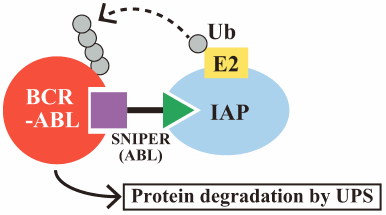 Graphical Abstract Fullsize Image抄録全体を表示PDF形式でダウンロード (1244K) HTML形式で全画面表示
Graphical Abstract Fullsize Image抄録全体を表示PDF形式でダウンロード (1244K) HTML形式で全画面表示 -
Takashi Nakada, Kiyoshi Sugihara, Takahiro Jikoh, Yuki Abe, Toshinori ...2019 年67 巻3 号 p. 173-185
発行日: 2019/03/01
公開日: 2019/03/01
ジャーナル フリー HTMLA major limitation of traditional chemotherapy for cancer is dose-limiting toxicity, caused by the exposure of non-tumor cells to cytotoxic agents. Use of molecular targeted drugs, such as specific kinase inhibitors and monoclonal antibodies, is a possible solution to overcome this limitation and has achieved clinical success so far. Use of an antibody–drug conjugate (ADC) is a rational strategy for improving efficacy and reducing systemic adverse events. ADCs use antibodies selectively to deliver a potent cytotoxic agent to tumor cells, thus drastically improving the therapeutic index of chemotherapeutic agents. Lessons learned from clinical failure of early ADCs during the 1980s to 90s have recently led to improvements in ADC technology, and resulted in the approval of four novel ADCs. Nonetheless, further advances in ADC technology are still required to streamline their clinical efficacy and reduce toxicity. [fam-] Trastuzumab deruxtecan (DS-8201a) is a next-generation ADC that satisfies these requirements based on currently available evidence. DS-8201a has several innovative features; a highly potent novel payload with a high drug-to-antibody ratio, good homogeneity, a tumor-selective cleavable linker, stable linker-payload in circulation, and a short systemic half-life cytotoxic agent in vivo; the released cytotoxic payload could exert a bystander effect. With respect to its preclinical profiles, DS-8201a could provide a valuable therapy with a great potential against HER2-expressing cancers in clinical settings. In a phase I trial, DS-8201a showed acceptable safety profiles with potential therapeutic efficacy, with the wide therapeutic index.
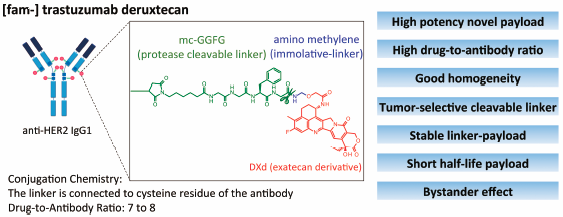 Graphical Abstract Fullsize Image抄録全体を表示PDF形式でダウンロード (1961K) HTML形式で全画面表示
Graphical Abstract Fullsize Image抄録全体を表示PDF形式でダウンロード (1961K) HTML形式で全画面表示 -
Takefumi Onodera, Isao Momose, Manabu Kawada2019 年67 巻3 号 p. 186-191
発行日: 2019/03/01
公開日: 2019/03/01
ジャーナル フリー HTMLGold compounds have a long history of use in medicine. Auranofin was developed more than 30 years ago as an oral therapy for rheumatoid arthritis. Now, however, auranofin is rarely used in clinical practice despite its efficacy for treating rheumatoid arthritis because more novel antirheumatic medications are available. Although its use in clinical practice has decreased, studies on auranofin have continued and it shows promise for the treatment of several different diseases, including cancer and bacterial and parasitic infections. Several potential novel applications of auranofin for treating human disease have been proposed. Auranofin inhibits the activity of thioredoxin reductase (TrxR), an enzyme of the thioredoxin (Trx) system that is important for maintaining the intracellular redox state. Particularly in cancers, TrxR inhibition leads to an increase in cellular oxidative stress and induces apoptosis. TrxR overexpression is associated with aggressive tumor progression and poor survival in patients with breast, ovarian, and lung cancers. The Trx system may represent an attractive target for the development of new cancer treatments. Therefore, the TrxR inhibitor auranofin may be a potent anticancer agent. This review summarizes the current understanding of auranofin for cancer therapy.
 Graphical Abstract Fullsize Image抄録全体を表示PDF形式でダウンロード (992K) HTML形式で全画面表示
Graphical Abstract Fullsize Image抄録全体を表示PDF形式でダウンロード (992K) HTML形式で全画面表示
-
Yosuke Ota, Arisa Nakamura, Elghareeb E. Elboray, Yukihiro Itoh, Takay ...2019 年67 巻3 号 p. 192-195
発行日: 2019/03/01
公開日: 2019/03/01
[早期公開] 公開日: 2018/10/24ジャーナル フリー HTML
電子付録Prodrug approaches are useful for enhancing the efficacies and reducing the side effects of anticancer drugs. Previously, we proposed a prodrug strategy for targeting cancers overexpressing lysine-specific demethylase 1 (LSD1), namely, conjugates of trans-2-phenylcyclopropylamine (PCPA, an LSD1 inhibitor) and anticancer drugs. In this study, we applied this prodrug strategy to the anticancer agent 5-fluorouracil (5-FU). In vitro assays showed that the PCPA-5-FU conjugate (1) released 5-FU upon the inhibition of LSD1. Furthermore, the conjugate (1) exerted an antiproliferative effect on colon cancer HCT116 cells. Thus, the PCPA-5-FU conjugate (1) was able to function as a prodrug of 5-FU, activated by LSD1 inhibition, and provided a useful new lead structure for further development.
 Graphical Abstract Fullsize Image抄録全体を表示PDF形式でダウンロード (777K) HTML形式で全画面表示
Graphical Abstract Fullsize Image抄録全体を表示PDF形式でダウンロード (777K) HTML形式で全画面表示 -
Takaya Togo, Youhei Sohma, Yoichiro Kuninobu, Motomu Kanai2019 年67 巻3 号 p. 196-198
発行日: 2019/03/01
公開日: 2019/03/01
[早期公開] 公開日: 2018/10/04ジャーナル フリー HTML
電子付録We developed a palladium-catalyzed C–H N-heteroarylation of N-protected-2,5-disubstituted imidazoles at the C4-position using N-heteroaryl halides as a coupling partner. Intensive reaction condition screening led us to identify fluorinated bathophenanthroline 7 as the optimum ligand for the palladium catalyst. This reaction will enhance lead optimization of drug candidates by facilitating the synthesis of heterobiaryl compounds containing an imidazole ring.
 Graphical Abstract Fullsize Image抄録全体を表示PDF形式でダウンロード (961K) HTML形式で全画面表示
Graphical Abstract Fullsize Image抄録全体を表示PDF形式でダウンロード (961K) HTML形式で全画面表示 -
Keisuke Tachibana, Kenji Ishimoto, Rika Takahashi, Hirokazu Kadono, Ta ...2019 年67 巻3 号 p. 199-202
発行日: 2019/03/01
公開日: 2019/03/01
ジャーナル フリー HTML
電子付録Peroxisome proliferator-activated receptors (PPARs) belong to the nuclear hormone receptor superfamily and include three subtypes (PPARα, PPARδ, and PPARγ). They regulate gene expression in a ligand-dependent manner. PPARα plays an important role in lipid metabolism. PPARγ is involved in glucose metabolism and is a potential therapeutic target in Type 2 diabetes. PPARδ ligands are candidates for the treatment of metabolic disorders. Thus, the detection of PPAR ligands may facilitate the treatment of various diseases. In this study, to identify PPAR ligands, we engineered reporter cell lines that can be used to quantify PPARγ and PPARδ activity. We evaluated several known ligands using these reporter cell lines and confirmed that they are useful for PPAR ligand detection. Furthermore, we evaluated extracts of approximately 200 natural resources and found various extracts that enhance reporter gene activity. Finally, we identified a main alkaloid of the Evodia fruit, evodiamine, as a PPARγ activator using this screening tool. These results suggest that the established reporter cell lines may serve as a useful cell-based screening tool for finding PPAR ligands to ameliorate metabolic syndromes.
 Graphical Abstract Fullsize Image抄録全体を表示PDF形式でダウンロード (564K) HTML形式で全画面表示
Graphical Abstract Fullsize Image抄録全体を表示PDF形式でダウンロード (564K) HTML形式で全画面表示
-
Nobumichi Ohoka, Osamu Ujikawa, Kenichiro Shimokawa, Tomoya Sameshima, ...2019 年67 巻3 号 p. 203-209
発行日: 2019/03/01
公開日: 2019/03/01
[早期公開] 公開日: 2018/10/26ジャーナル フリー HTML
電子付録Targeted protein degradation by small molecules is an emerging modality with significant potential for drug discovery. We previously developed chimeric molecules, termed specific and non-genetic inhibitor of apoptosis protein (IAP)-dependent protein erasers (SNIPERs), which induce the ubiquitylation and proteasomal degradation of target proteins. This degradation is mediated by the IAPs; the target proteins include bromodomain-containing protein 4 (BRD4), an epigenetic regulator protein. The SNIPER that degrades this particular protein, SNIPER(BRD)-1, consists of an IAP antagonist LCL-161 derivative and a bromodomain and extra-terminal (BET) inhibitor, (+)-JQ-1. SNIPER(BRD)-1 also degrades a cellular inhibitor of apoptosis protein 1 (cIAP1) and an X-linked inhibitor of apoptosis protein (XIAP), the mechanisms of which are not well understood. Here, we show that the degradation of cIAP1 and XIAP by SNIPER(BRD)-1 is induced via different mechanisms. Using a chemical biology-based approach, we developed two inactive SNIPERs, SNIPER(BRD)-3 and SNIPER(BRD)-4, incapable of degrading BRD4. SNIPER(BRD)-3 contained an N-methylated LCL-161 derivative as the IAP ligand, which prevented it from binding IAPs, and resulted in the abrogated degradation of cIAP1, XIAP, and BRD4. SNIPER(BRD)-4, however, incorporated the enantiomer (−)-JQ-1 which was incapable of binding BRD4; this SNIPER degraded cIAP1 but lost the ability to degrade XIAP and BRD4. Furthermore, a mixture of the ligands, (+)-JQ-1 and LCL-161, induced the degradation of cIAP1, but not XIAP and BRD4. These results indicate that cIAP1 degradation is triggered by the binding of the IAP antagonist module to induce autoubiquitylation of cIAP1, whereas a ternary complex formation is required for the SNIPER-induced degradation of XIAP and BRD4.
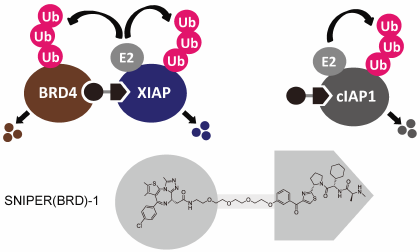 Graphical Abstract Fullsize Image抄録全体を表示PDF形式でダウンロード (1707K) HTML形式で全画面表示
Graphical Abstract Fullsize Image抄録全体を表示PDF形式でダウンロード (1707K) HTML形式で全画面表示 -
Ryosuke Ishida, Hirokazu Matsumoto, Sayaka Ichii, Motomasa Kobayashi, ...2019 年67 巻3 号 p. 210-223
発行日: 2019/03/01
公開日: 2019/03/01
[早期公開] 公開日: 2018/11/14ジャーナル フリー HTML
電子付録The tumor microenvironment is considered as one of the important targets for anticancer drug discovery. In particular, nutrient deficiency may be observed in tumor microenvironment; biakamides A–D (1–4) isolated from marine sponge Petrosaspongia sp. as growth inhibitors against cancer cells adapted to glucose-deprived conditions have potential as new drugs and tools for elucidating adaptation mechanisms to these conditions. In this paper, we investigated structure–activity relationship (SAR) of biakamide to create easily accessible analog and gain insights about participation of the substructures to growth–inhibitory activity toward development of anticancer drug. This work revealed that 14,15-dinor-biakamide C (5), which is easily accessible, has similar activity to natural biakamide C (3). In addition, detailed SAR study showed the terminal acyl chain is important for interacting with target molecule and amide part including thiazole ring has acceptability to convert structures without losing activity.
 Graphical Abstract Fullsize Image抄録全体を表示PDF形式でダウンロード (974K) HTML形式で全画面表示
Graphical Abstract Fullsize Image抄録全体を表示PDF形式でダウンロード (974K) HTML形式で全画面表示 -
Katsuhiko Sekimata, Tomohiro Sato, Naoki Sakai, Hisami Watanabe, Chiem ...2019 年67 巻3 号 p. 224-235
発行日: 2019/03/01
公開日: 2019/03/01
ジャーナル フリー HTMLMutant activin receptor-like kinase-2 (ALK2) was reported to be closely associated with the pathogenesis of fibrodysplasia ossificans progressiva (FOP) and diffuse intrinsic pontine glioma (DIPG), and therefore presents an attractive target for therapeutic intervention. Through in silico virtual screenings and structure–activity relationship studies assisted by X-ray crystallographic analyses, a novel series of bis-heteroaryl pyrazole was identified as potent inhibitors of ALK2 (R206H). Derived from in silico hit compound RK-59638 (6a), compound 18p was identified as a potent inhibitor of ALK2 (R206H) with good aqueous solubility, liver microsomal stability, and oral bioavailability.
 Graphical Abstract Fullsize Image抄録全体を表示PDF形式でダウンロード (1767K) HTML形式で全画面表示
Graphical Abstract Fullsize Image抄録全体を表示PDF形式でダウンロード (1767K) HTML形式で全画面表示 -
Hirofumi Ochiai, Kenta Yoshida, Hiroshi Shibutani, Akio Kanatani, Yuji ...2019 年67 巻3 号 p. 236-243
発行日: 2019/03/01
公開日: 2019/03/01
[早期公開] 公開日: 2018/10/10ジャーナル フリー HTMLReversibly glycosylated conjugates were developed by adding complex-type N-linked oligosaccharides to peptides through self-cleavable linkers with the aim of increasing the solubility and stability of the peptides in plasma. The amino or carboxyl group of the peptide was connected to a glycosylated Ascendis or ester/thioester-type linker, respectively. Use of the linkers enabled extended release of the peptides depending on the pH and temperature of the buffer according to a first order reaction, and their cleavage rate was also affected by the structure of the peptide-linker coupling. This tunability will allow optimization towards the intended use of the peptides to be released. Furthermore, because glycosylation is a reliable method of greatly increasing the solubility of a peptide, the presented glycosylated linkers are expected to permit the preparation of antibodies in aqueous buffers even in the case of sparingly soluble antigen peptides.
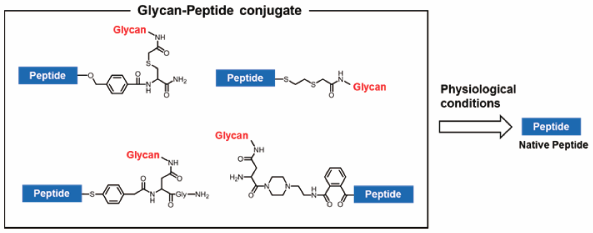 Graphical Abstract Fullsize Image抄録全体を表示PDF形式でダウンロード (1802K) HTML形式で全画面表示
Graphical Abstract Fullsize Image抄録全体を表示PDF形式でダウンロード (1802K) HTML形式で全画面表示
-
Si-peng Wu, Dan Li, Ning Wang, Jin-cai Hou, Li Zhao2019 年67 巻3 号 p. 244-252
発行日: 2019/03/01
公開日: 2019/03/01
[早期公開] 公開日: 2018/12/28ジャーナル フリー HTMLYiqi Tongluo Granule (YQTL) is a kind of proprietary Chinese medicine, manufactured by China Shineway Pharmaceutical Group Ltd., under the authority of China Food and Drug Administration (CFDA) treating cardiovascular and cerebrovascular diseases such as ischemic stroke in China, however the underlying mechanism of YQTL on treating ischemic stroke has not been revealed. This study is aimed to evaluate the protective effect of YQTL on cerebral ischemia/reperfusion (I/R) injury and inquire into its underlying mechanisms. Cerebral I/R injury was induced by occluding the middle cerebral artery for 2 h followed by 24 h reperfusion. And regional cerebral flow was monitored by Laser Doppler flow during ischemia phase. The infarct volume was evaluated by Triphenyte-trazolium chloride staining. The protective effects of YQTL were assessed by a number of parameters, including neurological scores, regional cerebral blood flow, pathological changes of neuron in hippocampuses and hippocampus calcium level. The proteins of extracellular signal-regulated kinase (ERK), N-methyl D-aspartate receptor subtype 2B (GluN2B) and p-calcium-dependent protein kinaseII (CaMKII) response were assayed by Western blotting. I/R caused significant change in neurological deficit scores, regional cerebral flow and infarct volume. However results in YQTL groups and Nimodipine Tablets (NMDP) group were reversed. Subsequently YQTL reduced I/R-induced calcium influx. Results of hematoxylin–eosin staining manifested that YQTL significantly improved neuronal injury after I/R in rats. Meanwhile, microdialysis data demonstrated that extracellular glutamate was increased in the striatum during ischemia reperfusion, which was reduced by YQTL. YQTL and mitogen-activated protein extracellular kinase (MEK) inhibitor suppressed the I/R-mediated over-expression of GluN2B, p-ERK, ERK and p-CaMKII proteins expression. Putting these together, our results suggest that YQTL played a neuroprotective role in cerebral I/R injury, which might be exerted by inhibiting the excitotoxicity and expression of GluN2B, p-CaMKII and MEK/ERK signal pathway.
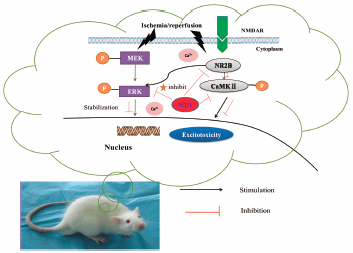 Graphical Abstract Fullsize Image抄録全体を表示PDF形式でダウンロード (2541K) HTML形式で全画面表示
Graphical Abstract Fullsize Image抄録全体を表示PDF形式でダウンロード (2541K) HTML形式で全画面表示 -
Risako Kameda, Takuto Sohma, Kazuya Kobayashi, Ryosuke Uchiyama, Kazut ...2019 年67 巻3 号 p. 253-257
発行日: 2019/03/01
公開日: 2019/03/01
ジャーナル フリー HTML
電子付録The plant alkaloids, iso-6-spectaline and spectaline, isolated from the Cassia or Senna genera contain a characteristic 2,6-disubstituted piperidin-3-ol scaffold. Although both natural products are reported to exhibit a variety of interesting biological activities, few stereo-selective schemes for the construction of the 2,6-disubstituted scaffold have been reported. Following our previous studies regarding the synthesis of (+)-spectaline, herein we report the first convergent synthesis of (−)-iso-6-spectaline using a cross-metathesis under thermal conditions where the cis-2,6-disubstituted piperidin-3-ol scaffold is condensed with a long alkyl chain containing a terminal olefin. The cis-2,6-disubstituted piperidin-3-ol used in the synthesis was prepared simply via Pd(II)-catalyzed diastereoselective cyclization. It was confirmed that (+)-spectaline, an epimer of (−)-iso-6-spectaline, was selectively synthesized by the cross-metathesis reaction under less intense thermal conditions starting from the same cis-2,6-disubstituted piperidin-3-ol derivative.
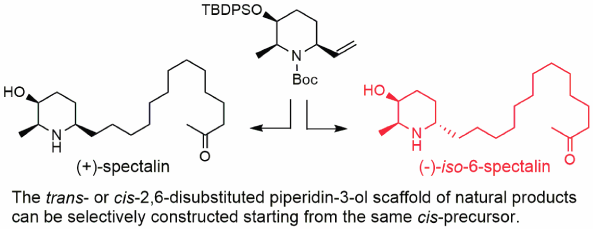 Graphical Abstract Fullsize Image抄録全体を表示PDF形式でダウンロード (587K) HTML形式で全画面表示
Graphical Abstract Fullsize Image抄録全体を表示PDF形式でダウンロード (587K) HTML形式で全画面表示 -
 Bing Leng, Yuan Chao Xue, Wen Zhang, Tian tian Gao, Gen quan Yan, Hui ...2019 年67 巻3 号 p. 258-264
Bing Leng, Yuan Chao Xue, Wen Zhang, Tian tian Gao, Gen quan Yan, Hui ...2019 年67 巻3 号 p. 258-264
発行日: 2019/03/01
公開日: 2019/03/01
ジャーナル フリー HTMLA number of clinical trials demonstrated that tigecycline was effective and well tolerated in the treatment of patients with various bacterial infections, but few literatures had shown the coagulopathy induced by tigecycline. To address this concern, we performed a retrospective analysis to assess the impact of tigecycline treatment on coagulation parameters in 50 patients with bacterial infections in our hospital (Shandong Provincial Hospital, China). These patients were treated with tigecycline at Shandong Provincial Hospital in 2015–2016 at either a recommended (50 mg q12h) or a higher dose (100 mg q12h). Coagulation parameters, including Fibrinogen (FIB) levels, prothrombin time (PT), activated partial thromboplastin time (aPTT), platelet count (PLT) and D-dimer, were evaluated in order to assess the impact of tigecycline treatment in these severely infected patients. What we found was that the plasma fibrinogen (FIB) level was 4.63 ± 1.56 g/L before tigecycline treatment, and decreased to 2.92 ± 1.23 g/L during treatment, which was statistically significant (p < 0.001). The mean values of aPTT and PT were significantly increased from 39.58 ± 8.72 to 44.05 ± 10.45 s (p = 0.002), and from 15.37 ± 1.53 to 16.37 ± 2.64 s (p = 0.004), respectively. This study demonstrates that treatment of tigecycline could reduce FIB, prolong aPTT and PT. In conclusion, we advise that it is necessary for practitioners routinely monitor coagulation level in at-rick patient populations treated with tigecycline.
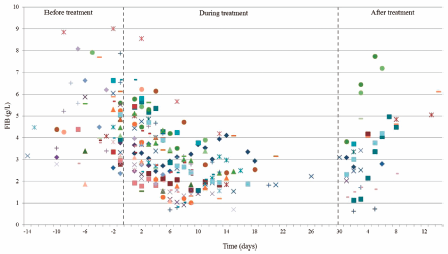 Graphical Abstract Fullsize Image抄録全体を表示Editor's pick
Graphical Abstract Fullsize Image抄録全体を表示Editor's pickA number of clinical trials demonstrated that tigecycline was effective and well tolerated in the treatment of patients with various bacterial infections, but few literatures had shown the coagulopathy induced by tigecycline. The retrospective analysis in this paper to assess the impact of tigecycline on coagulation parameters in 50 patients showed that the plasma fibrinogen (FIB) level decreased during treatment, which was statistically significant (P < 0.001). The mean values of activated partial thromboplastin time (aPTT) and prothrombin time (PT) were significantly increased, respectively. It is necessary for practitioners routinely monitor coagulation level in at-rick patient populations treated with tigecycline.
PDF形式でダウンロード (694K) HTML形式で全画面表示 -
Kotaro Okada, Daijiro Hirai, Yoshihiro Hayashi, Shungo Kumada, Atsushi ...2019 年67 巻3 号 p. 265-270
発行日: 2019/03/01
公開日: 2019/03/01
ジャーナル フリー HTML
電子付録The aim of this study was to demonstrate the usefulness of the time-domain NMR (TD-NMR) method to characterize the crystalline state of active pharmaceutical ingredients (APIs) containing a solid dispersion. In this study, indomethacin (IMC) was used as a model for poorly water-soluble API. Solid dispersions of IMC were prepared with polyvinylpyrrolidone (PVP) at different weight ratios. First, we measured the T1 relaxation behavior of solid dispersions. From the result, the T1 relaxation time (T1) changed according to the API content; the T1 tended to increase with increasing API content because the T1 value of amorphous IMC was longer than that of PVP. Next, we tried to monitor the amorphous-to-crystalline transformation of IMC in the solid dispersion during the thermal stress test. In the case of solid dispersion containing 90% IMC, a clear prolongation of the T1 could be observed during the thermal stress test. From the powder X-ray diffraction patterns, the change in T1 relaxation behavior must be caused by the IMC transformation from amorphous to crystalline. From these findings, we were successful in monitoring the IMC amorphous-to-crystalline transformation by the changes in T1 relaxation behavior. Our findings led us to conclude that TD-NMR is a novel approach for the evaluation of crystalline state of APIs in solid dispersions.
 Graphical Abstract Fullsize Image抄録全体を表示PDF形式でダウンロード (757K) HTML形式で全画面表示
Graphical Abstract Fullsize Image抄録全体を表示PDF形式でダウンロード (757K) HTML形式で全画面表示 -
 Terushi Ito, Kotaro Okada, Kok Hoong Leong, Daijiro Hirai, Yoshihiro H ...2019 年67 巻3 号 p. 271-276
Terushi Ito, Kotaro Okada, Kok Hoong Leong, Daijiro Hirai, Yoshihiro H ...2019 年67 巻3 号 p. 271-276
発行日: 2019/03/01
公開日: 2019/03/01
ジャーナル フリー HTMLThe different states of water incorporated in wet granules were studied by a low-field benchtop 1H-NMR time-domain NMR (TD-NMR) instrument. Wet granules consisting different fillers [cornstarch (CS), microcrystalline cellulose (MCC), and D-mannitol (MAN)] with different water contents were prepared using a high-speed granulator, and then their spin–spin relaxation time (T2) was measured using the NMR relaxation technique. The experimental T2 relaxation curves were analyzed by the two-component curve fitting, and then the individual T2 relaxation behaviors of solid and water in wet granules were identified. According to the observed T2 values, it was confirmed that the molecular mobility of water in CS and MCC granules was more restricted than that in the MAN granule. The state of water appeared to be associated with the drying efficiency and moisture absorption capacity of wet granules. Thus, it was confirmed that the state of water significantly affected the wet granulation process and the characteristics of the resultant granules. In the final phase of this study, the effects of binders on the molecular mobility of water in granulation fluids and wet granules were examined. The state of water in granulation fluids was substantially changed by changing the binders. The difference was still detected in wet granules prepared by addition of these fluids to the fillers. In conclusion, TD-NMR can offer valuable knowledge on wet granulation from the viewpoint of molecular mobility of water.
 Graphical Abstract Fullsize Image抄録全体を表示Editor's pick
Graphical Abstract Fullsize Image抄録全体を表示Editor's pickWet granulation is one of the fundamental unit operations for manufacturing pharmaceutical solid dosage forms including tablets. This study investigated in detail the states of water incorporated in wet granules composed of different fillers. The key instrument to evaluate the state of water was a low-field benchtop 1H-NMR time-domain NMR (TD-NMR). This study successfully concluded that the state of water significantly affected the wet granulation process and the characteristics of the resultant granules. The findings can offer valuable knowledge on wet granulation process from the viewpoint of molecular mobility of water.
PDF形式でダウンロード (498K) HTML形式で全画面表示 -
Ippei Watanabe, Hirotaka Hoshi, Miwako Sato, Kiyoshi Suzuki2019 年67 巻3 号 p. 277-283
発行日: 2019/03/01
公開日: 2019/03/01
ジャーナル フリー HTMLThe purpose of this study is to evaluate the usefulness of the rheological properties and adhesive force of ophthalmic viscosurgical devices (OVDs) as parameters for understanding and identifying the surgical behavior of cohesive and dispersive OVDs. The apparent viscosity, and the storage and loss moduli (dynamic rheological parameters) of 50% chondroitin sulfate (CS), 3% sodium hyaluronate (HA), Shellgan (the combination of 3% HA and 4% CS), Opegan (1% HA with a low molecular mass) and Opegan-Hi (1% HA with a high molecular mass) were obtained with a rheometer. The adhesive force of each sample was measured by using a texture analyzer. Opegan-Hi showed a solid-like behavior, while 50% CS showed a fluid-like behavior from their apparent viscosity and dynamic rheological parameters. Shellgan, 3% HA, and Opegan exhibited similar rheological properties and intermediate characteristics between Opegan-Hi and 50% CS, although their respective values were slightly different. Among these OVD samples, the adhesive force was higher in the order of 50% CS > Shellgan, 3% HA > Opegan > Opegan-Hi. The adhesive force of dispersive OVDs tended to be higher than that of cohesive OVDs, which correlated well with the removal times of OVDs from the eye that have previously been reported. In conclusion, we demonstrated that cohesive OVDs and dispersive OVDs have particular rheological and adhesive properties that can be applied to identify both types. These parameters obtained in this study provide useful information for a greater understanding and prediction of the behavior of OVDs in the eye during surgery.
 Graphical Abstract Fullsize Image抄録全体を表示PDF形式でダウンロード (1615K) HTML形式で全画面表示
Graphical Abstract Fullsize Image抄録全体を表示PDF形式でダウンロード (1615K) HTML形式で全画面表示
-
Takatoshi Sakamoto, Shigeto Kachi, Shohei Nakamura, Hiroshi Yuasa2019 年67 巻3 号 p. 284-288
発行日: 2019/03/01
公開日: 2019/03/01
ジャーナル フリー HTMLThis study aimed to clarify the effects of magnesium oxide (MgO) on the hardness of orally disintegrating tablets (ODTs) during storage. ODTs containing a range of MgO concentrations were prepared by direct powder compression and stored for up to 4 weeks in an unpackaged condition at 40°C, with 75% relative humidity. Tablets that did not contain MgO showed a significant decrease in hardness after one week in storage, while those containing MgO at a mass fraction of ≥4% maintained their hardness for up to 4 weeks. The tablet disintegration times after storage were equivalent to those observed before storage (approximately 30 s), regardless of the MgO level. Furthermore, the dissolution behavior of a model drug (acetaminophen) from the ODTs was not affected by the level of MgO. These findings revealed that the addition of MgO suppressed the reduction in ODT hardness during storage in the unpackaged state, without delaying tablet disintegration or inhibiting drug release.
 Graphical Abstract Fullsize Image抄録全体を表示PDF形式でダウンロード (559K) HTML形式で全画面表示
Graphical Abstract Fullsize Image抄録全体を表示PDF形式でダウンロード (559K) HTML形式で全画面表示
- |<
- <
- 1
- >
- >|